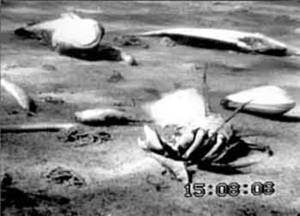Crabs and other crustaceans in the ocean could be the first to suffocate in the increasing number of marine "dead zones" in the world, areas where there is little or no oxygen. What's more, the extent of oxygen deprivation in the oceans could be much larger than previously thought.
These are the findings of a study from Mediterranean Institute for Advanced Studies in Spain published by Raquel Vaquer-Sunyer and Carlos M. Duarte in the journal PNAS this week which looked at how well different types of bottom-dwelling marine creature can tolerate lowered levels of oxygen in the water in the laboratory.
 |
| Picture of the sea floor in the Western Baltic covered with dead or dying crabs, fish and clams killed by oxygen depletion © Kils @ Wikimedia |
The researchers searched through hundreds of other previously published studies of two hundred different species to investigate exactly what the threshold level of oxygen is for life in the oceans to be sustained.
What they found was that there is quite a range in the tolerance of different species to restricted oxygen. Some like the American Oyster can put up with virtually no oxygen, while others are much more sensitive - the young larvae of the rock crab will die if there is less than 8.6mg of 02 in every litre of water.
The problem of lowering levels of oxygen in the oceans stems mainly from a process known as eutrophication, which is triggered by nutrients - mostly agricultural fertilisers - washing off land and into coastal waters. Higher levels of nitrates and phosphates cause algal blooms, both of large seaweeds and single celled phytoplankton. When the algae die they sinks to the seabed where bacteria break them down, using up all the oxygen in the water and leading to the so-called "dead zones".
Climate change may also make the problem worse since warmer water holds less oxygen.
A study published earlier this year in the journal Science revealed that there has been an exponential increase since the 1960s in the number of "dead zones" in the world, which currently cover around 245,000 square kilometres.
That study defined dead zones based on a threshold level of around 2 mg of oxygen per litre. What this latest study now suggests is that the threshold could in fact be as high as 4.6 mg of O2 per litre, which would meant the total extent of marine dead zones could be far greater than was previously thought.
All in all, this means that we made need to think again about the health of the oceans and for water quality standards to be set accordingly to tackle the increasing extent of marine dead zones.










Comments
Add a comment